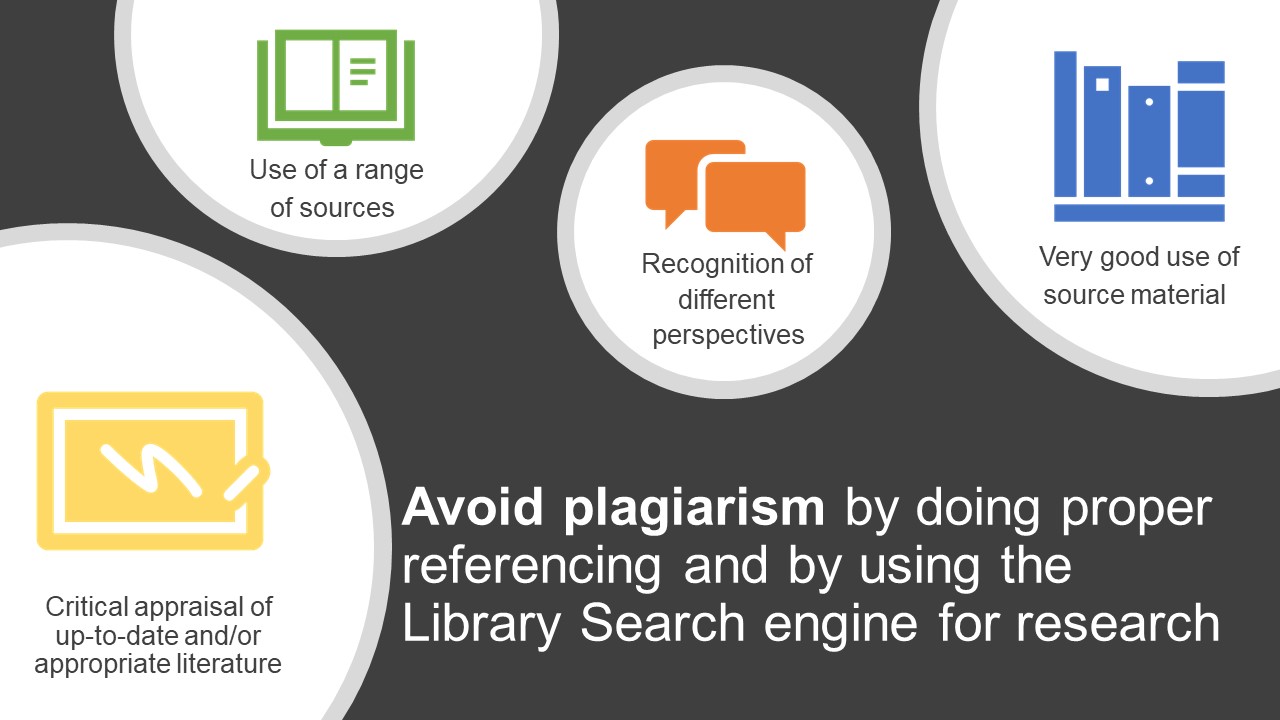
Avoid plagiarism by referencing the resources you use in your work
Plagiarism is using other people's work in your own work without acknowledging the authors. It is also sharing your work with other students and submitting the same work (collusion). If you plagiarise, you may fail and may be asked to attend an academic misconduct awareness course. You may also be asked to attend an academic misconduct awareness course if you used Google as the only source for your work instead of Library Search.
You can avoid plagiarism easily by using Library Search instead of Google, by not sharing your work with others, and by separating other people's words from your own words when you use their work in your own work. You also have to credit the authors briefly in the body of your work (in-text citations) and credit them fully at the end of your work (reference list). This process is called referencing and you can find out all about it in our Referencing section.
Explore the sections below on how to separate other people’s words from your own words in your work. Book a session if you need help.
Basics
You can use other people’s work in your own work in various ways:
- By directly quoting (i.e. copying and pasting or typing an author’s words exactly as they are)
- By paraphrasing (i.e. using your own words to describe what the author is saying)
- By summarising (e.g. explaining a theory in a whole book or article)
Then, in order to avoid plagiarism, you need to complete these two essential parts in your work to acknowledge the sources you have used:
- Identify your sources by mentioning the author, date, and page number/s (if applicable) briefly in the body of your work immediately when you quote/paraphrase/summarise someone else’s work: this is called citation or in-text citation (see here how to do it - requires logging in)
- List each of your sources in detail (author/s, date, title, publication details, etc.) at the end of your work in alphabetical order by author’s surname: this is called a reference list or bibliography (see here what details to include in your reference list - requires logging in)
Direct quotations
If you use direct quotations, there are strict rules for separating your words from what you have taken from someone else.
You may use short direct quotations (couple of sentences) or longer direct quotations (a whole paragraph, for example). There are different rules for separating them from your own words.
- A short quotation should start and end with quotation marks. After you close the quotation mark, you then immediately enter your in-text citation in round parentheses according to the rules set out in the Cite them right guide. See examples here (requires logging in).
- A long quotation should be entered as an indented new paragraph, by leaving space between your words and the quotation – you do not use quotation marks anymore. At the end of the paragraph, you immediately enter your in-text citation in round parentheses according to rules set out in the Cite them right guide. See example here (requires logging in).
Paraphrasing
When paraphrasing, you are not using the author’s words exactly as they are; so, you do not use quotation marks or separate paragraphs anymore.
Because you are using your own language and style, the placement of the in-text citation may vary: it does not need to be at the end of the sentence. Also, all the information required may not be in the round parentheses – some of the information can be outside the round parentheses. See example here (requires logging in).
Summarising
The rules are similar to paraphrasing. You are using your own language and style to summarise the main points of a work; therefore, there is flexibility with the placement and contents of the in-text citation. Also, page numbers are not applicable anymore. See example here (requires logging in).
Reference list or Bibliography
A reference list is a list of everything you read and quoted/paraphrased/summarised from in your work. Your assignments are more likely to have a reference list at the end as they are short pieces of work.
A bibliography is generally for bigger pieces of work, for dissertations and major projects. It includes everything you read as background reading in preparation for wiritng your work as well as everything you read and quoted/paraphrased/summarised from in your work.
You should start creating your reference list or bibliography as you go along when you start writing. As soon as you enter your in-text citation, you should scroll down to the bottom of your work and complete your reference list entry as well. If you do not do it immediately, you may forget it and your in-text citations and reference list entries may not match. See here for how your citations and reference list should match (requires logging in).